
Clinical Pathology
Scope & Guideline
Championing Open Access to Transformative Medical Knowledge
Introduction
Aims and Scopes
- Molecular Pathology and Genomics:
Focuses on the application of molecular techniques in the diagnosis and characterization of diseases, including various cancers and genetic disorders, enhancing precision medicine. - Diagnostic Techniques and Innovations:
Covers advancements in diagnostic methodologies, including histopathology, cytopathology, and immunohistochemistry, aimed at improving diagnostic accuracy and efficiency. - Laboratory Medicine and Quality Assurance:
Explores best practices in laboratory management, including quality control measures, laboratory stewardship, and the implementation of clinical decision support systems. - Clinical Case Reports and Reviews:
Presents unique clinical cases and comprehensive reviews that contribute to the understanding of rare diseases and complex diagnostic challenges. - Public Health and Epidemiology:
Addresses the role of clinical pathology in public health, including studies on disease prevalence, laboratory responses to pandemics, and the impact of social determinants on health outcomes.
Trending and Emerging
- Artificial Intelligence and Machine Learning:
The integration of AI and machine learning into pathology is gaining momentum, with research focusing on automating diagnostic processes and improving accuracy in disease detection. - Liquid Biopsy and Non-Invasive Diagnostics:
There is a growing interest in liquid biopsy techniques for cancer diagnosis and monitoring, representing a shift towards less invasive methods of obtaining critical diagnostic information. - Personalized Medicine and Targeted Therapies:
Research is increasingly focusing on molecular profiling and the use of biomarkers to tailor treatment strategies for individual patients, particularly in oncology. - Telepathology and Remote Diagnostics:
The COVID-19 pandemic has accelerated the adoption of telepathology, with studies exploring its efficacy and applications in remote diagnostics and consultations. - Health Equity and Access to Laboratory Services:
Emerging themes highlight the importance of addressing disparities in healthcare access and outcomes, particularly in underrepresented populations, emphasizing the role of pathology in public health.
Declining or Waning
- Traditional Histopathology Techniques:
There has been a noticeable decline in papers focused solely on traditional histopathological methods as the field shifts towards integrating molecular diagnostics and advanced imaging techniques. - General Microbiology Studies:
Research centered on basic microbiology has waned as more emphasis is placed on molecular microbiology and the use of advanced diagnostic techniques in infectious disease management. - Basic Laboratory Techniques:
Papers focusing on fundamental laboratory techniques, such as manual blood counts and basic serological tests, have decreased as automation and advanced technologies gain traction. - Classic Blood Transfusion Practices:
The literature on traditional blood transfusion practices is declining as new guidelines and technologies, such as pathogen reduction techniques and personalized transfusion strategies, become more prominent. - Pathology Education without Technological Integration:
The decline in papers discussing pathology education that do not incorporate technology reflects the increasing necessity for digital literacy and technological competencies in pathology training.
Similar Journals
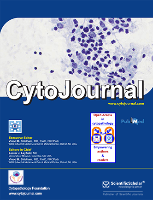
CytoJournal
Advancing the Frontiers of Cytopathology and Forensic Medicine.CytoJournal is a leading open-access journal focused on the fields of pathology and forensic medicine, published by SCIENTIFIC SCHOLAR LLC. With its esteemed reputation, the journal has achieved a Q2 ranking in the 2023 Category Quartiles in its field, indicating its significant contribution and impact among its peers. Over its convergence from 2004 to 2024, CytoJournal has established itself as a pivotal platform for researchers, professionals, and students to disseminate and exchange pioneering research findings related to cytopathology and diagnostic techniques. With an emerging Scopus rank of #115 out of 208 in the field, the journal maintains a solid percentile ranking of 44th, underlining its importance in the scientific community. CytoJournal's commitment to facilitating open access ensures that critical insights and advancements in pathology and forensic medicine are easily accessible to those at the forefront of this essential area of study.
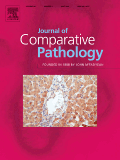
JOURNAL OF COMPARATIVE PATHOLOGY
Pioneering Research in Pathology and Forensic MedicineJOURNAL OF COMPARATIVE PATHOLOGY, published by Elsevier Science Ltd, stands as a significant publication within the fields of pathology and forensic medicine, as well as veterinary studies. With an ISSN of 0021-9975 and an E-ISSN of 1532-3129, this journal has been disseminating critical research since 1950, contributing to the advancement of knowledge through its focus on comparative pathology. The journal's reputable standing is underscored by its Q3 classification in Pathology and Forensic Medicine and Q2 in Veterinary (miscellaneous) for 2023, reflecting its vital role in shaping contemporary discourse in these domains. The Scopus ranks further solidify its presence, placing it at the 51st percentile in general veterinary sciences and the 32nd percentile in pathology—a testament to the quality and relevance of the contributions it publishes. Although it operates under a subscription model, the journal remains accessible to researchers and practitioners who aim to deepen their understanding of pathological phenomena across species, enhance diagnostic accuracy, and improve clinical practices. With a steadfast commitment to rigorous peer review and a global readership, the JOURNAL OF COMPARATIVE PATHOLOGY is an essential resource for those engaged in research and professional practice, fostering collaborations and innovations that bridge complementary areas of study.
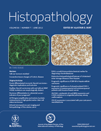
HISTOPATHOLOGY
Connecting Scholars to Cutting-edge Pathological DiscoveriesHISTOPATHOLOGY is a premier scholarly journal published by WILEY, targeting the fields of histology, pathology, and forensic medicine. With an ISSN of 0309-0167 and an E-ISSN of 1365-2559, this esteemed journal has maintained a strong academic presence since its inception in 1977. Boasting an impressive Q1 ranking in crucial categories such as Histology and Pathology, it ranks 13th out of 208 in Pathology and Forensic Medicine, and 5th out of 62 in Histology, reflecting its high impact and relevance within the scientific community. HISTOPATHOLOGY serves as a critical platform for disseminating significant research findings, reviews, and advancements in the diagnostic and therapeutic aspects of pathology. Although it does not operate under an open access model, its rigorous peer-review process ensures that published articles uphold the highest standards of scientific integrity. Scholars and practitioners alike benefit from the insights shared in this journal, as it aims to bridge the gap between laboratory science and clinical practice, fostering innovation and enhancing our understanding of disease mechanisms.

APPLIED IMMUNOHISTOCHEMISTRY & MOLECULAR MORPHOLOGY
Bridging the gap between theory and practice in immunohistochemistry.Applied Immunohistochemistry & Molecular Morphology, published by Lippincott Williams & Wilkins, stands as a pivotal resource within the fields of histology, medical laboratory technology, and pathology. With an ISSN of 1541-2016 and an E-ISSN of 1533-4058, this journal has been contributing significant research and advancements since its inception in 1996. It serves a diverse audience, including researchers, professionals, and students, aiming to enhance the understanding of immunohistochemical techniques and molecular morphology. Recognized for its quality, it holds category quartiles of Q3 in histology and Q2 in medical laboratory technology and pathology and forensic medicine as of 2023. The journal's rigorous peer-review process ensures that only the most impactful findings are disseminated, thus advancing the education and practice in these critical domains of study. Though it is not an open-access journal, it remains essential for keeping abreast of the latest methodological innovations and applications in pathology and laboratory science, as evidenced by its respectable Scopus rankings and the continual convergence of groundbreaking research published through 2024.
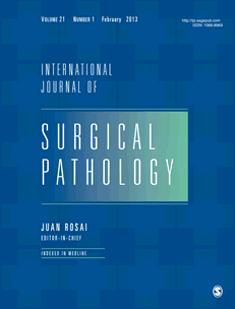
INTERNATIONAL JOURNAL OF SURGICAL PATHOLOGY
Shaping the Future of Anatomy and SurgeryInternational Journal of Surgical Pathology is a distinguished peer-reviewed journal published by SAGE Publications Inc since 1993, specializing in the intricate fields of surgical pathology, anatomy, and surgery. With an ISSN of 1066-8969 and an E-ISSN of 1940-2465, this journal has been at the forefront of disseminating vital research that helps shape clinical practices and understanding in surgical diagnostics. Ranked in the Q2 category for Anatomy and garnering Q3 status in Pathology and Forensic Medicine as well as Surgery, the journal holds a commendable position within its field as reflected by its Scopus ranks. The impact factor underscores its influence and relevance, making it an essential resource for researchers, professionals, and students alike, looking to stay abreast of advancements in surgical pathology. However, please note that the journal does not currently offer open access options. As it converges through the years from 1993 to 2024, the International Journal of Surgical Pathology continues to uphold its commitment to excellence in medical research.

International Journal of Clinical and Experimental Pathology
Innovating the Future of Clinical and Experimental PathologyInternational Journal of Clinical and Experimental Pathology, published by E-CENTURY PUBLISHING CORP, serves as a vital resource for professionals in the field of pathology. With its ISSN 1936-2625, the journal has positioned itself within the competitive landscape of medical journals, achieving commendable rankings in Scopus, particularly in the categories of Pathology and Forensic Medicine (Rank #98/185) and Histology (Rank #38/58). Although its coverage in Scopus has been discontinued, the journal’s past contributions from 2009 to 2017 continue to be a touchstone for researchers interested in advancing their understanding of clinical and experimental pathology. The open-access format ensures accessibility to a wide audience, fostering collaboration and education in this essential medical discipline. By bridging clinical research and experimental findings, this journal plays a crucial role in disseminating knowledge and enhancing practices within pathology, making it an indispensable tool for researchers, professionals, and students alike.
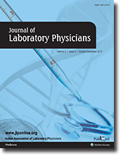
Journal of Laboratory Physicians
Fostering collaboration for a brighter future in laboratory medicine.The Journal of Laboratory Physicians is a prestigious, peer-reviewed publication dedicated to advancing the field of laboratory medicine. Published by THIEME MEDICAL PUBL INC, this journal has established itself as a vital source of research and clinical insights since its inception, transitioning to Open Access in 2009 to broaden its reach and accessibility. With an ISSN of 0974-2727 and an E-ISSN of 0974-7826, it aims to provide a platform for professionals, researchers, and students engaged in laboratory-based studies to share critical findings and foster collaboration across disciplines. The journal's scope encompasses a wide range of topics relevant to laboratory physicians, ensuring that it remains an essential resource for those seeking to stay on the cutting edge of laboratory practices and innovations. By disseminating timely research and reviews, the Journal of Laboratory Physicians plays a crucial role in enhancing the quality of healthcare through improved laboratory services.
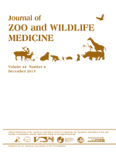
JOURNAL OF ZOO AND WILDLIFE MEDICINE
Advancing veterinary science for wildlife health.JOURNAL OF ZOO AND WILDLIFE MEDICINE, published by the American Association of Zoo Veterinarians, serves as a pivotal resource in the field of veterinary science, focusing specifically on the health and well-being of zoo and wildlife species. With an ISSN of 1042-7260 and an E-ISSN of 1937-2825, this journal is recognized for its significant contributions to animal science and has been categorized in the second quartile in both Animal Science and Zoology, as well as Veterinary disciplines, according to the latest rankings. It holds a respectable position within Scopus, being ranked #91 in General Veterinary and #290 in Animal Science and Zoology. While the journal operates on a subscription basis, its impactful research articles have been invaluable for clinicians, researchers, and students alike, providing crucial insights that advance wildlife conservation, veterinary practices, and animal health care from 1993 to the present. With a global reach and a targeted focus on both theoretical and practical applications, JOURNAL OF ZOO AND WILDLIFE MEDICINE is instrumental in fostering collaboration among professionals dedicated to the study and care of wild animal populations.
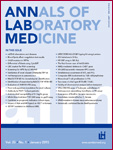
Annals of Laboratory Medicine
Unlocking the Potential of Laboratory ScienceAnnals of Laboratory Medicine, published by the KOREAN SOC LABORATORY MEDICINE, stands as a pivotal resource for researchers and practitioners in the fields of clinical and medical biochemistry. With a strong Q2 ranking in both Biochemistry (medical) and Clinical Biochemistry, along with a prestigious Q1 status in miscellaneous Medicine categories, this journal emphasizes the significance of laboratory medicine in improving patient outcomes and advancing scientific understanding. Established in 2012, the journal has demonstrated an impressive trajectory of growth and scholarly contribution, making it a reliable source of high-quality research and insightful reviews. The journal utilizes open access, enhancing the reach of its findings across the global scientific community. Operating from South Korea, Annals of Laboratory Medicine aims to foster dialogue and collaboration among professionals, contributing to the continuous advancement of laboratory methodologies and diagnostics.

Pathology and Laboratory Medicine International
Unveiling innovations for improved clinical outcomes.Pathology and Laboratory Medicine International is a premier open-access journal, published by DOVE MEDICAL PRESS LTD, dedicated to advancing the field of pathology and laboratory medicine. Since its inception in 2009, this journal has provided a vital platform for researchers, clinicians, and educators to disseminate findings, challenges, and innovations that shape laboratory practices and pathology diagnostics. With an emphasis on peer-reviewed, high-quality research, Pathology and Laboratory Medicine International aims to enhance knowledge and improve clinical outcomes by sharing best practices and emerging trends in the discipline. As an open-access publication, it ensures global accessibility to critical research findings, fostering an inclusive academic environment. The journal holds a commendable reputation within the scientific community, making it a valuable resource for students, professionals, and researchers committed to excellence in the field.